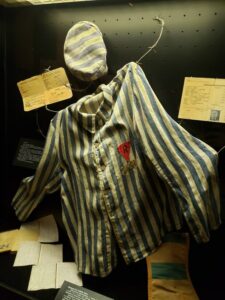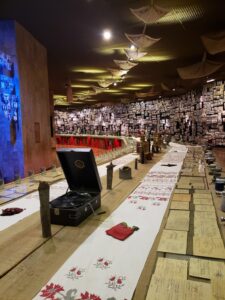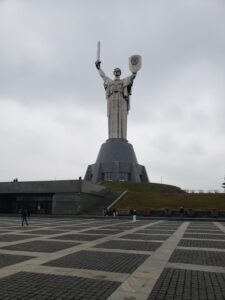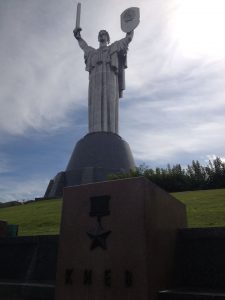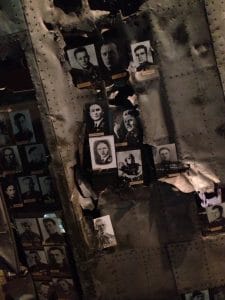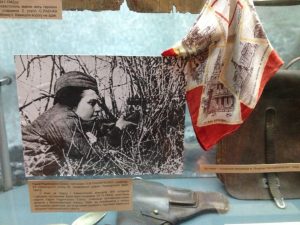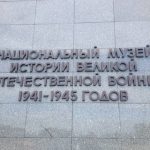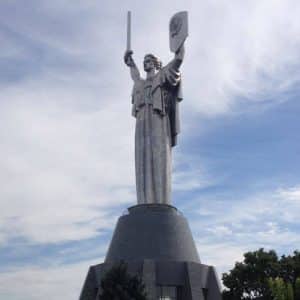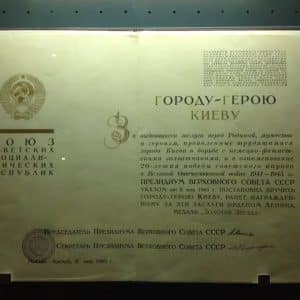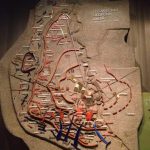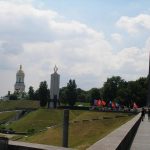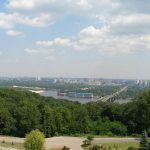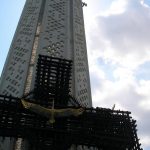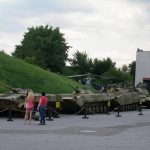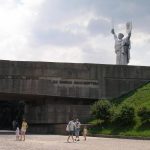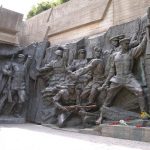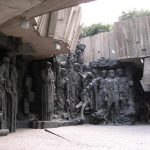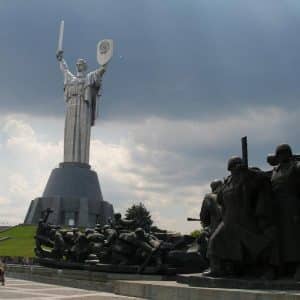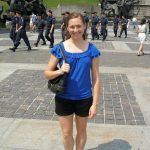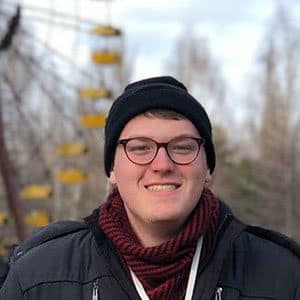On one of the great hills of Kyiv stands a colossus with sword and shield in hand. Her massive shield defends the country and her sword pierces the sky above the city. This is the Motherland Monument, a gigantic statue celebrating the Soviet victory in World War II. This statue stands taller than the Statue of Liberty and her base houses the National Museum of the History of Ukraine in the Second World War.
A tour of this unique museum in generally included with SRAS study abroad programs in Kyiv. Below are two experiences that SRAS students have had with The National Museum of the History of Ukraine in the Second World War.
Jonah Helwig (2020)
My visit to this museum, as part of my included cultural program with my SRAS/Novamova study abroad program in Kyiv, was of special interest to me as a historian for its perspectives on how Ukrainians interpret their complicated history.
During World War II, Ukrainians were divided, most were fighting for the USSR, but others chose to fight for the Nazis. This fact was highlighted throughout the museum as the main tragedy of World War II for the Ukrainian people. Although most histories of WWII in Eastern Europe focus extensively on the Jewish Holocaust, and although Ukraine lost most of its Jewish population at this time, with 1.3 million killed and 850,000 fleeing, this museum chooses another focus, the brutalization of Ukraine as a whole as it was caught between two great waring empires.
The focal point is thus how Ukrainian citizens were treated by the Soviets and Nazis. There was a large emphasis on the scorched earth policy adopted by the Soviets as the Nazis began to invade the USSR.
This policy saw agricultural land, infrastructure, and strategic positions burned or otherwise destroyed as the Red Army retreated so that the Nazis could not use them. This had a devastating effect on the Ukrainian people as they were taken over by the Nazis and left with nothing but ashes by the Soviets.
The museum goes on to show the atrocities of the infamous concentration camps but with an emphasis on the plight of the Soviet prisoners of war. The museum showcases several gut-wrenching torture devices used against the Soviet POWs. The Nazis’ treatment of prisoners of war was truly atrocious but no better fate awaited Red army soldiers who surrendered or deserted or who escaped the Nazis after capture and returned home. These soldiers, the museum shows, were sent to the Gulag. This captures the plight of the Ukrainian people in World War II perfectly. They were simply damned if they did fight the Nazis and damned if they did not. This is the tragedy that the museum aims to portray.
It also houses a new exhibition of artifacts from the war in Donbass. This goes a step further to highlight the division of the Ukrainian people by showing the separation that exists to this day. The exhibit details the battles and has artifacts such as helmets, flags, and even one of the ambulances used during the fighting. It is truly chilling to see these artifacts knowing they once belonged to a soldier on the frontlines who lost his or her life to defend Ukraine. The exhibit plays well into the theme of division as it captures Ukrainians fighting Ukrainians in the present day as well as during World War II.
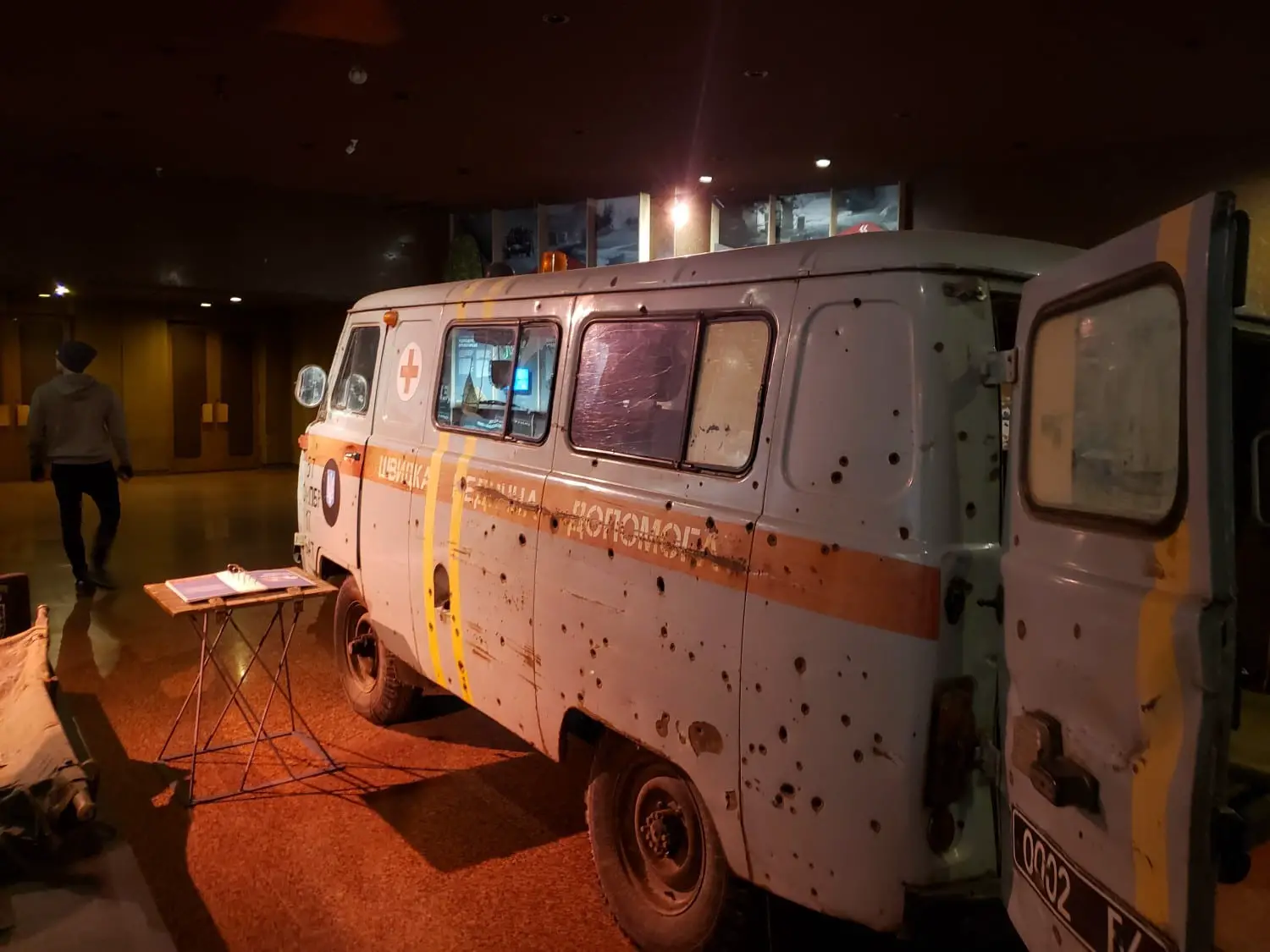
The National Museum of the History of Ukraine in the Second World War is truly a must-see attraction in Kyiv. It is a sobering experience to see just how Ukraine was affected in the Second World War. When we think of World War II, especially for Americans, we instantly think of Pearl Harbor and the Holocaust, about a battle of right forces against wrong. However, the reality on the ground in Eastern Europe was dizzyingly complex, with almost no path to a happy survival, and with long-lasting consequences for the local population. As Ukraine strives to establish its own identity after what it sees as decades of occupation, this museum reminds us of Ukraine’s unique history, which is both intertwined with the USSR’s and individual.
Alexander Wilson (2013)
As a student of Russian and East European history, one of the most interesting excursions I took during my time while studying abroad in Kyiv was to the National Museum of the Great Patriotic War of 1941-1945, or “Великой Отечественной Воины 1941-1945 Годов.” (Note: the museum has since changed its name to “National Museum of the History of Ukraine in the Second World War,” adopting the Western name for the conflict and droping the name used by the USSR and still used by Russia.)
A challenging phrase for beginning Russian speakers to pronounce – and a difficult one for a history student from America to remember, in place of the simpler Western version “Second World War” – the Great Patriotic War of 1941-1945 touched the lives of everyone in the Soviet Union, and Ukraine was especially hard-hit. In order to commemorate the titanic struggle between the USSR and Nazi Germany, the museum was opened in 1981, along with the accompanying “Rodina Mat” or “Mother Motherland” statue that towers above the Dnieper River. Today, some 30 years later, the museum’s 300,000+ exhibits serve as an informative reminder of the immensity and intensity of the fight for the Motherland.
The approach to the museum leaves visitors in awe even before they enter. The path down to the museum from downtown Kyiv is accompanied by inspiring Russian military music and the impressive sight of the mighty Rodina Mat statue – taller than the Statue of Liberty by a full 16 meters, or 42 feet. After passing a military vehicle park and monuments to each “hero city” of the Soviet Union, one finally reaches the entrance to the museum, where the full name is spelled out in bronze characters. Bags must be checked and photography passes purchased for a minimal fee (if you want to take pictures) before proceeding through the museum’s main exhibits.
My group from NovaMova had reserved a guided tour, in Russian, the fee for which was included in my SRAS program costs for Kyiv. Our guide proved to be very knowledgeable and very talkative, and while he spoke rather quickly, most of us with at least intermediate Russian proficiency were able to understand the vast majority of what he said. Considering the vast number of historical artifacts and exhibits in the museum – the scope of which is staggering, even for someone with a passion for the subject matter – our guide did not touch upon every display, but rather walked us through the course of the war. The key events of each stage of the conflict were explained to us, starting with Operation Barbarossa and the Nazi invasion in June 1941, continuing through the struggles for Kyiv in 1943 and 1944, and ending with the fall of Berlin to Soviet forces 1945.
Along the way, our museum guide made sure to discuss some of the lesser-known and lesser-appreciated aspects of the war, including the Ukrainian partisan movement, female snipers, and the vital contributions of Ukrainian mothers and factory workers to the Soviet victory. No aspect of the Great Patriotic War is left untouched by the museum – fitting given the fact that the conflict claimed the lives of more than 20 million people in the Soviet Union, and forever changed the lives of millions more. The sacrifices and heroism of the war were commemorated at the end of our tour, underneath the base of the Rodina Mat statue, where the names of every Hero of the Soviet Union are inscribed on the walls.
With such an expansive collection of exhibits, the National Museum of the Great Patriotic War of 1941-1945 can feel a bit overwhelming at times, so a guided tour and photography pass are both recommended as ways to help make the experience more manageable and memorable. Also, since the tour was only in Russian, beginning students may find themselves a bit lost at times, but usually someone else on the tour is more than happy to help with translation. And if you decide to visit the museum on your own, make sure to give yourself adequate time to proceed through the exhibits. Two hours would be a recommended minimum; anything less is not only impractical, but almost disrespectful to the lives and memories of those who fought and died in the Great Patriotic War.
Marie Forney (2013)
Without a doubt, one of the most iconic landmarks of Kyiv and Ukraine is the 62-meter-tall, titanium “Motherland” («Мати-Батькiвщина» in Ukrainian) statue, which prominently stands amidst the hills of the Dnieper River’s right-bank, and it is a must-see for all Kyiv visitors. “Mother Motherland” holds a 16-meter-long, 9-ton sword vertically in the sky with her right hand and clutches a 13×8-meter shield bearing the Soviet coat of arms in her left. But as spectacular and impressive as the statue is in itself, it is only part of a grand memorial complex which commemorates the German-Soviet War of 1941-1945.
Located in the southern outskirts of Kyiv’s Perchersk district (Печерський район), this memorial complex spans approximately 25 acres of a hill overlooking the Dnieper River. I had the opportunity to tour the complex with a native Ukrainian through an arrangement made by the NovaMova International Language School (where SRAS classes are held). After spending a couple of hours sight-seeing, practicing Russian, and enjoying мороженое (ice cream) in the nearby Park of Eternal Glory (which also contains a number of prominent museums and memorials), we walked towards the grandiose statue of Mother Motherland.
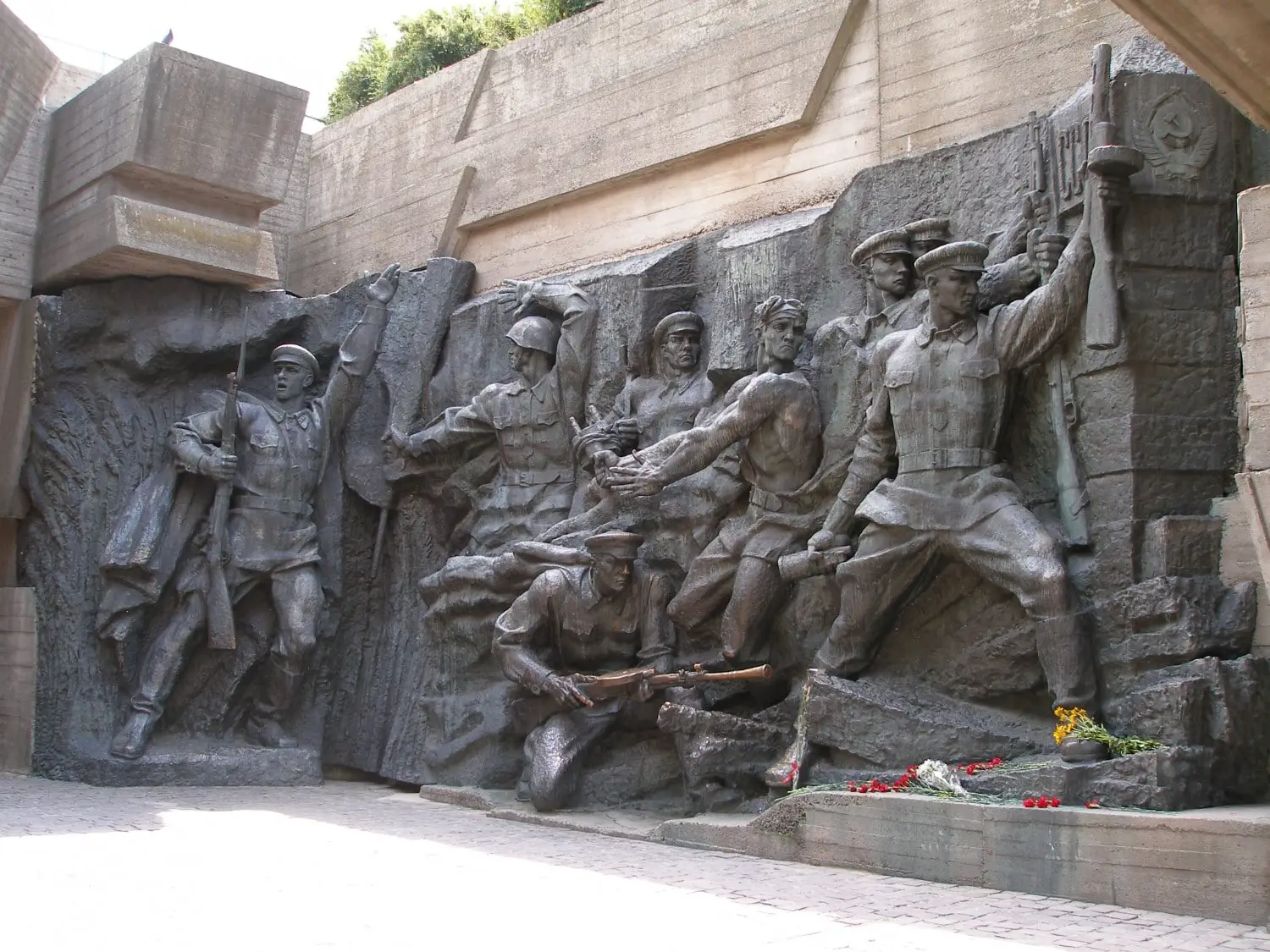
As we approached the monument, we walked through the memorial’s main square and “Valley of Hero-Cities,” a title the Soviets gave to those cities where major battles were fought. We then encountered the giant “Fire of Glory” bowl (a huge concrete cup that occasionally cradles a tongue of fire), and massive bronze and stone sculptural compositions (named “Fording the Dnipro,” “Transfer of Weapons,” and “Heroes of the Front and Rear”). My experience of viewing these larger-than-life depictions of Soviet strength, courage, and sacrifice was enhanced by Russian military music, which echoed from speakers between the sculptured open-air walls. My guide commented to me in Russian that you just can’t get the full Soviet effect without Soviet military march music!
We also passed the “Exposition of Fighting Vehicles and Weaponry,” which displayed tanks, helicopters, and a jet fighter, but since it was starting to rain, we did not spend much time there. When we reached the base of the Motherland monument, we entered the National Museum of the History of the Great Patriotic War of 1941-1945. We passed through the museum doors with a group of Ukrainian troops who happened to be touring the museum at the same time, and our coincidental meeting seemed to make the museum-going experience even more authentically Ukrainian for me, which I appreciated.
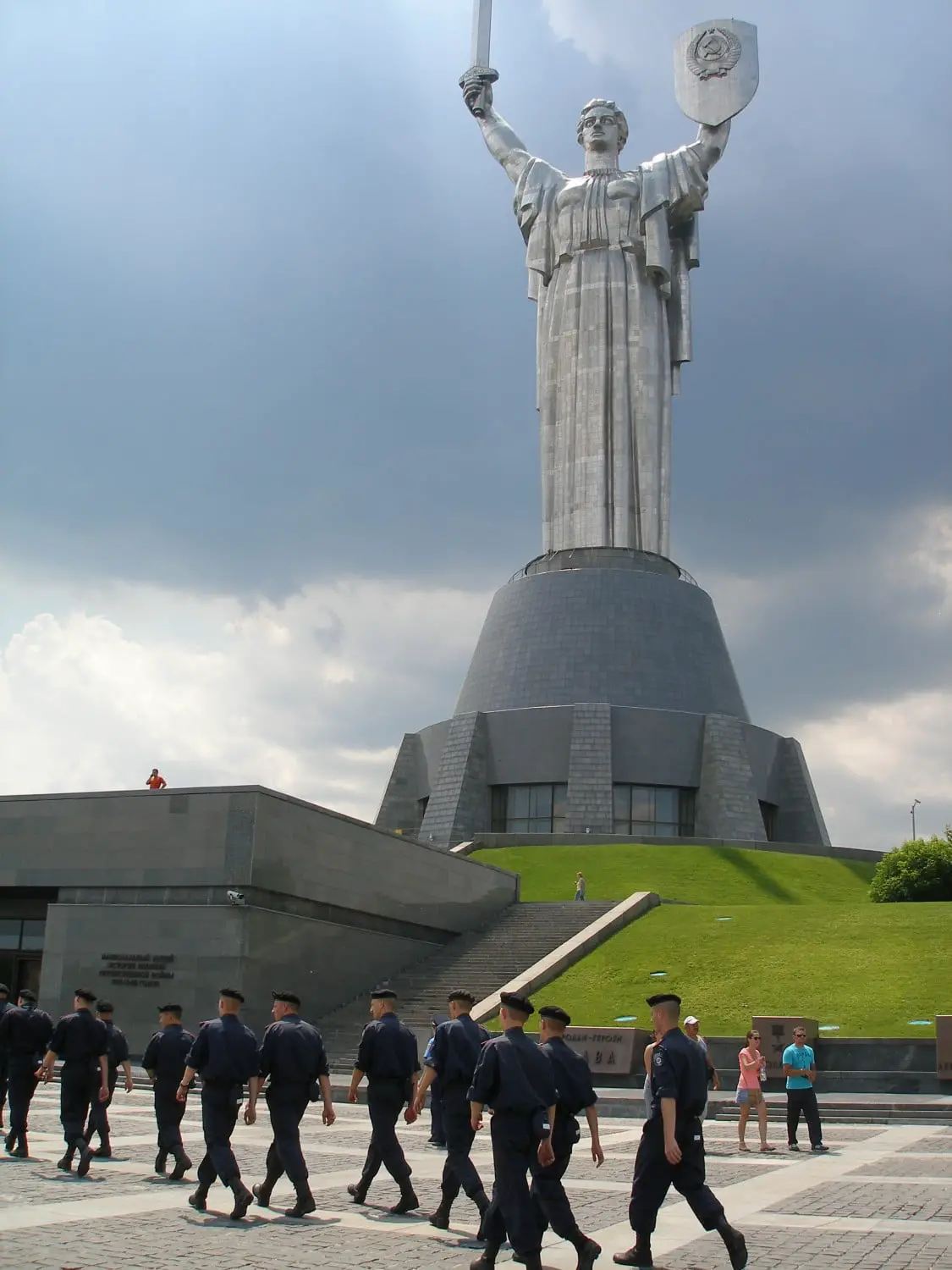
The museum is a three-story building that functions both as a pedestal for the Motherland statue and as a home for over 300,000 exhibits, making it one of the largest museums in Ukraine. Upon entering the museum, guests have the option of purchasing a staff-led tour along with an admission ticket. My friend and I decided to forego this option and simply read the complimentary placards and exhibit captions, as well as momentarily listened-in on some group tours that were taking place near us in the exhibition rooms.
I was thoroughly impressed by the size, scope, and design of the museum and its contents. The main lobby is an open area of polished stone with a staircase leading up to the second and third exhibition floors as well as down to the basement, where museum guests can rest at a café modeled after traditional Soviet-style pubs.
All three exhibition floors are circular. On the first and second floors, visitors progress through a series of connected rooms and wind up back at the main lobby. Each room is filled with carefully-placed relics, documents, models, and photographs which tell of the horrors and heroes who witnessed and took part in the German-Soviet war. The entrance of each room also offers placards in English, Ukrainian, Russian, and German, providing a general description of the historical realities. The exhibitions range from an old Nazi airplane and automobile, to weapons, to official documents, to clothing and other personal items. Not only do displays line the walls, but they hang from the ceilings and rest on the floor, filling the centers of all the rooms!
The third floor is smaller in circumference than the others. Atop it is the Motherland statue. It is lined with marble walls on which names are carved and painted in gold – names of more than 11,600 soldiers and over 200 workers of the home-front who were given the titles of “Hero of the Soviet Union” and “Hero of Socialist Labor.” For a small cost, visitors may step out onto the third-floor balcony to view Kyiv City and the Dnieper River. For a greater cost, guests may ascend the Motherland statue and lookout from various view-points. My friend and I agreed that we were satisfied with the view from within the third-floor windows and from the “Fire of Glory” look-out, so we briefly visited the basement’s café and headed home.
Although my couple of hours at the museum were largely spent struggling to comprehend the quickly-spoken, information-packed discourse of my friend and guide, I was heavily impacted by the visual displays and written descriptions in the museum. I came away with greater knowledge and insight into a monumental piece of Soviet history that still greatly affects Ukrainians today. To date, over 21 million visitors have attended the museum, and I don’t think a trip to Kyiv, whether brief or extended, can be complete without a visit to this grandiose memorial complex.
More Photos of the National Museum of the History of Ukraine in the Second World War
Alexander Wilson
Marie Forney



